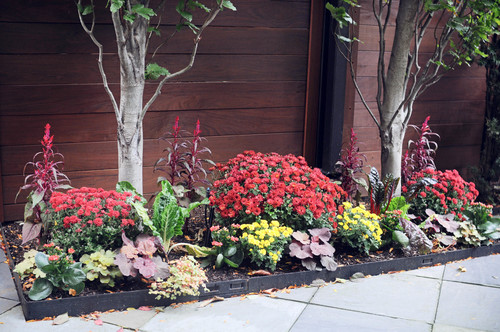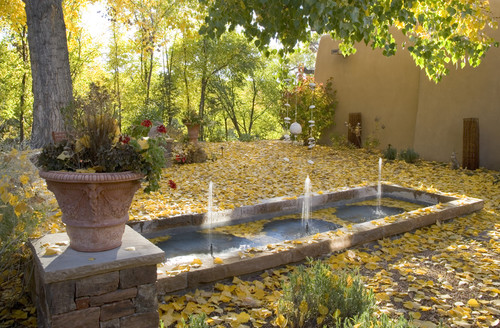
Nikada/iStock
Sure, lots of homeowners dig into their dirt with gusto in the spring, but fall is also a prime time to do some much-needed gardening and yard maintenance that will pay off down the road.
According to Lester Poole, Lowe’s live nursery specialist, even though the temperatures are falling now, the ground is still warm enough for roots to develop. In fact, some plants and shrubs actually thrive in colder weather.
So before you put away your gardening tools and call it quits, make use of these fall yard maintenance tips to keep your greenery going through the winter.
1. Create a clean slate
Photo by Bliss Garden Design, LLC
For the best-looking garden, both now and next spring, doing a fall cleanup of your lawn and flowerbeds is a must.
“By removing plant debris and raking up dead leaves, you’ll decrease pests, disease, and weed seeds that overwinter,” explains Rhianna Miller, a garden and landscape design expert with Rubber Mulch.
To tackle this task, clear away fallen branches and decaying plants and cut back perennials, such as forsythia and peonies.
“You want to leave your beds as clean as you can, to prevent extra work in the spring,” Miller notes. And by cleaning up now, you’ll have a blank slate to showcase fall plantings.
2. Resist the urge to prune
Photo by KMS Gardens and Design
As you dive into your fall cleanup, don’t go overboard. It’s fine to pick up fallen branches and leaves, but don’t prune much, warns Poole. Trimming late in the year can actually encourage plants to grow more, creating vulnerable shoots that may become damaged during the first cold snap. If you must prune back bushes and shrubs, do so after all the leaves are down, he advises.
3. Plant hardy bulbs
Photo by Cording Landscape Design
Fall is the ideal time to plant perennial shrubs and hardy bulbs (tulips, daffodils, and hyacinths), as the ground retains enough heat and moisture, and because the winter and spring dormant period helps to minimize transplant shock, says Miller. Planting in the fall gives bulbs time to root and take advantage of the cooling hours to flower properly, adds Poole. But don’t confuse hardy bulbs with their more tender cousins, like caladiums, dahlias, and gladiolus, which are planted only in spring.
4. Use the right mulch
Photo by Clemens & Associates Inc.
Go green when it comes to fall gardening, by using ground-up fallen leaves as mulch in your vegetable and flower gardens. Composted leaves add humic acid, which gives a boost of energy to your garden once spring rolls around, says Poole. Other types of mulch to consider include shredded bark for most landscaping beds and pine straw for acid-loving azaleas and rhododendron, says Miller.
“Applying fall mulch insulates the soil and plant roots, and creates a warm environment for earthworms and microbes to stay active for longer, which improves your soil over time,” notes Miller.
Pro tip: Spread mulch after the first hard freeze, in a 3-inch-thick layer.
5. Bring inside tender pots and garden gear
Don’t forget to take delicate herb pots inside before the weather turns very cold. If you live in a temperate zone with little to no snow, you can simply move containers to a section of your deck where they’ll enjoy more sunlight or be sheltered from frost.
You’ll also need to gather up gardening equipment (hoses, nozzles, pots) and store it in a protected area, such as the garage, basement, or insulated outdoor shed. Terra-cotta pots in particular shouldn’t be exposed to repeated freezes, lest they crack and chip, notes Poole.
6. Check for disease
Photo by Noelle Johnson Landscape Consulting
Deep cracks in bark, patches of fungus, and dry, brittle branches all point to a tree in trouble. Spotting these problems is made easier once the leaves are down, so take advantage of the season. Get professional help if out-of-reach branches need removing; that way, they won’t drop in your yard—or worse, on your house—during winter.
7. Mum’s the word
Chrysanthemums are the classic fall plants that flood garden centers every year, so pick up a bunch to add color to your flowerbeds. If you’re looking for more variety in your fall planting, consider ginkgo biloba, with bright lemon leaves; burning bush, which offers fiery red foliage; Japanese maples; or Montauk daisies, suggests Poole. Add in a few pumpkins and gourds near your mailbox and entryways, and your fall look will be complete.
The post 7 Crucial Yard Maintenance Moves You May Forget to Do This Fall appeared first on Real Estate News & Insights | realtor.com®.







No comments:
Post a Comment